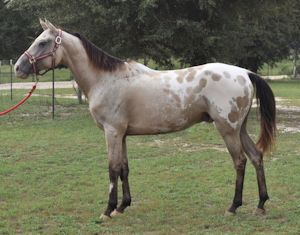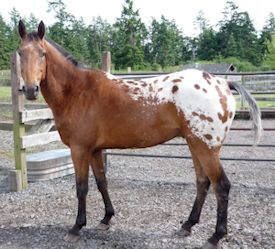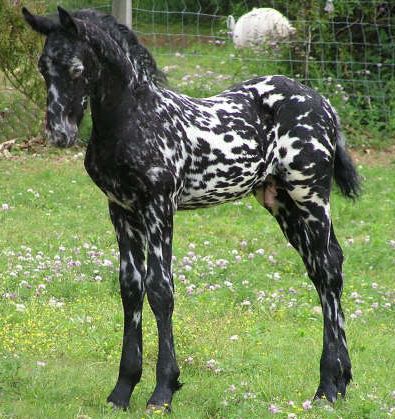The Nez Perce Tribe, historically, were the only known group of people indigenous to North America who, after becoming a society revolving around a horse culture, selectively raised horses that stood up to tests of racing, endurance and stamina resulting in an economy that flourished with the demand for their horses and also resulted in acclaim of legendary proportions throughout the world.
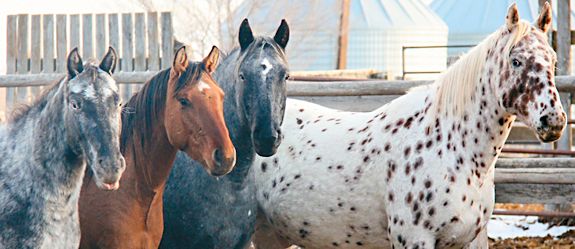
The Nez Perce or Nimiipu people originally referred to their type of horse as the Ma’amin.
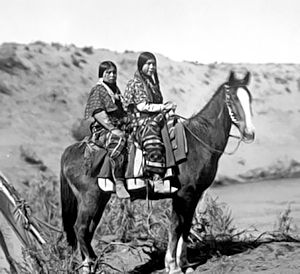 A selectively bred horse, noted and sought after by explorers, traders, and surrounding tribes, the Nez Perce horse flourished on the rich grasslands of the Palouse and numbered in the tens of thousands before disruption, war, and flight brought them to the world’s attention.
A selectively bred horse, noted and sought after by explorers, traders, and surrounding tribes, the Nez Perce horse flourished on the rich grasslands of the Palouse and numbered in the tens of thousands before disruption, war, and flight brought them to the world’s attention.
Prized as buffalo hunters and racehorses, many of these horses were lean, clean-limbed, long necked and resembled (some said) the “English courser.” Others were heavier-boned, rounder and more muscular, suited to their work as family pack and work horses. Often solid chestnuts, blacks, bays, and roans, these horses were sometimes pied, blanketed, frosted, or leopard-spotted.
No equine feat of courage and endurance is more famous or more spectacular than the 1877 flight of the Nez Perce.
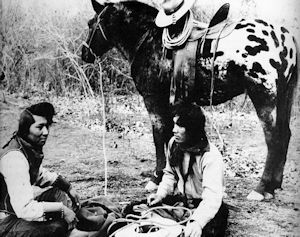 In that year, the United States Government demanded that the Wallowa band of Nez Perce leave their homeland forever and take up residence on a continually diminishing reservation. The band complied, but a wave of violence on both sides resulted, and, faced with the threat of an all-out war, a number of Nez Perce chose flight.
In that year, the United States Government demanded that the Wallowa band of Nez Perce leave their homeland forever and take up residence on a continually diminishing reservation. The band complied, but a wave of violence on both sides resulted, and, faced with the threat of an all-out war, a number of Nez Perce chose flight.
Between July and November of 1877, about 750 Nez Perce men, women, and children with over two thousand horses outran—sometimes by weeks—a similar force of U.S. Cavalry, and outmaneuvered intercepting contingents of local volunteers.
Through heat and freezing weather, traveling unshod over some of the world’s toughest terrain, surviving on nothing but available forage, turning on several occasions to do battle, these incredible horses proved far superior even to the tough cavalry mounts of the day.
 Over the course of five months, these horses carried their people—men and women, infants and the elderly—for over 1500 miles, an average of ten miles a day, often through new, unfamiliar, and treacherous country, and without benefit of trails, bridges, or the chance to rest, resupply, or recover from injuries.
Over the course of five months, these horses carried their people—men and women, infants and the elderly—for over 1500 miles, an average of ten miles a day, often through new, unfamiliar, and treacherous country, and without benefit of trails, bridges, or the chance to rest, resupply, or recover from injuries.
Destruction of the Nez Perce breeding stock
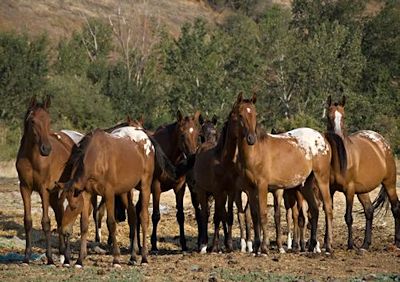 When the Nez Perce were finally intercepted a few miles from the Canadian border, most surrendered. Their remaining horses, (many of them starving and exhausted), were exterminated. Others were dispersed. Despite—or perhaps because of—the national fame these horses had won during this well-publicized feat of endurance, no move was made to preserve the breed’s integrity. Outcrossed through generations to ranch and draft horses, they were almost forgotten until 1938, when the efforts of Claude Thompson saved what he calculated to be a remaining few hundred horses from extinction. The Appaloosa Horse Registry began.
When the Nez Perce were finally intercepted a few miles from the Canadian border, most surrendered. Their remaining horses, (many of them starving and exhausted), were exterminated. Others were dispersed. Despite—or perhaps because of—the national fame these horses had won during this well-publicized feat of endurance, no move was made to preserve the breed’s integrity. Outcrossed through generations to ranch and draft horses, they were almost forgotten until 1938, when the efforts of Claude Thompson saved what he calculated to be a remaining few hundred horses from extinction. The Appaloosa Horse Registry began.
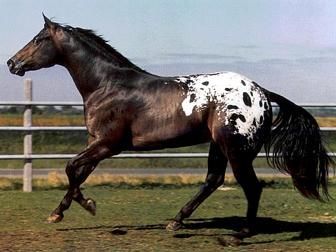 By the 1990’s the registration of horses with considerable Quarter Horse, Thoroughbred, and Arab influence, and the show-ring push toward color, heavy muscling, and refinement, had created a very different Appaloosa. As beautiful and versatile as it was, this horse had begun to lose many of the valued qualities of endurance, thrift, toughness, and courage that had made the original horse so famous and so prized.
By the 1990’s the registration of horses with considerable Quarter Horse, Thoroughbred, and Arab influence, and the show-ring push toward color, heavy muscling, and refinement, had created a very different Appaloosa. As beautiful and versatile as it was, this horse had begun to lose many of the valued qualities of endurance, thrift, toughness, and courage that had made the original horse so famous and so prized.
Revival of the Ma’amin breed, best remembered in the Nez Perce Appaloosa
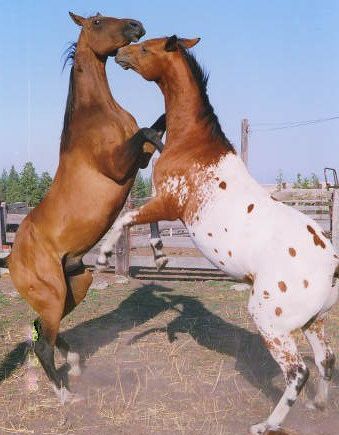 In the early 1990’s, in an effort to reclaim both their heritage as a renowned horse culture, and the qualities that had made the original Nez Perce horse so famous, members of the tribe began a breeding program with the intent to bring back the Nez Perce horse. The program began with Foundation ApHC stock, and Ma’amin horses recovered from the Minam line of Chief Joseph’s horses, kept pure on a ranch in the Wallowa valley.
In the early 1990’s, in an effort to reclaim both their heritage as a renowned horse culture, and the qualities that had made the original Nez Perce horse so famous, members of the tribe began a breeding program with the intent to bring back the Nez Perce horse. The program began with Foundation ApHC stock, and Ma’amin horses recovered from the Minam line of Chief Joseph’s horses, kept pure on a ranch in the Wallowa valley.
The obvious outcross was back to the Mustang. But genetic and historical research began to indicate that the foundation stock of the original Ma’amin was not of Mustang origin. Mustang or Mesteno horses tend to be traceable to old Spanish/Portugese stock: North African Arabians and Andalusian types.
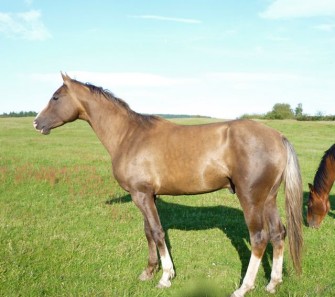 The Ma’amin horses more likely originated from stock left behind by Russian fur traders, who had an early presence in the Pacific Northwest. These were Eurasian horses, derived from the famous “Heavenly Horses” of Ghengis Khan, and traceable back to the Akhal Teke, a breed kept pure in Turkmenistan for over 2,000 years.
The Ma’amin horses more likely originated from stock left behind by Russian fur traders, who had an early presence in the Pacific Northwest. These were Eurasian horses, derived from the famous “Heavenly Horses” of Ghengis Khan, and traceable back to the Akhal Teke, a breed kept pure in Turkmenistan for over 2,000 years.
A rare breed, also world-renowned for its remarkable endurance, thrift, and courage, the Akhal Teke has a heritage remarkably similar to the Nez Perce horse. Tribal horse, race horse, war horse, family horse, the Akhal Teke was selectively bred for thousands of years on the dryland steppes of Turkmenistan, prized and sought after by others, then subjected to a deliberate program of Russian outcrossing and extermination, kept pure in small pockets of ancient stock to revive and flourish in this century as the national horse of Turkmenistan.
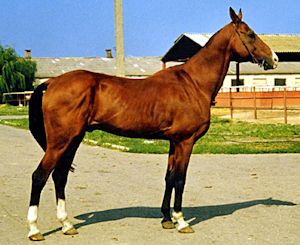 In the 1990’s only a handful of these rare Akhal Tekes had ever been exported. In 1995, the Nez Perce tribe acquired four of these stallions and two mares, and began the Nez Perce Horse Registry, recording the acceptable outcrosses of Akhal Teke and ApHC breeding.
In the 1990’s only a handful of these rare Akhal Tekes had ever been exported. In 1995, the Nez Perce tribe acquired four of these stallions and two mares, and began the Nez Perce Horse Registry, recording the acceptable outcrosses of Akhal Teke and ApHC breeding.
Still numbering fewer than a thousand horses, this new/old breed keeps alive the proud heritage of two ancient horse cultures. These horses have kept the qualities of their ancestors, bred and cherished in a world and time when a truly good horse was an honored family member whose strength and loyalty could mean the difference between life and death.
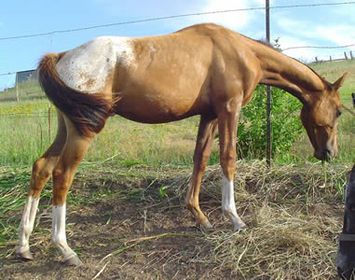 The Nez Perce horse brings together equine ambassadors of history and healing from two continents; their qualities today remind us of what horses and humans have long been capable of together.
The Nez Perce horse brings together equine ambassadors of history and healing from two continents; their qualities today remind us of what horses and humans have long been capable of together.
Breeders of the Nez Perce Horse
| Ronda Broncheau Rt. 2 Box 38 #1 Ruebens, ID 83548 http://www.nezpercehorse.com/ | Leroy & Karen Williams Rt 1 Box 49F Culdesac, ID 83524 |
| Shirley Jo Allman 360 Toll Road Kooskla, ID 83539 | Allen Pinkham Sr. Rt 1 Box 120 Lenore, ID 83541 |
| Chief Joseph Foundation P.O. Box 413 Lapwai, ID 83540 | Jon & Rose Yearout PO Box 231 Lapwai, ID 83540 http://www.nezperceappaloosas.com |
| Katrina O’Neal RR 1 Box 14172 Priest River, ID 83856 | Isabel Bond 641 N Hayes Moscow, ID 83843 |
| Karl & Milena Stoszek 1092 Wallen Road Moscow, ID 83843 | Rhonda and Kim Shoemaker RR#1214 RMB Fort Francis, Ontario, Canada P9A3M2 |
| Janet E. Campbell P.O. Box 77 Silver Star, MT 59751 Contact Phone # 406 287-9290 |
